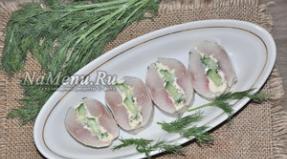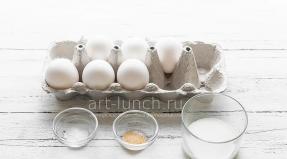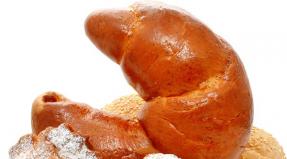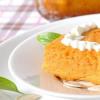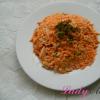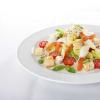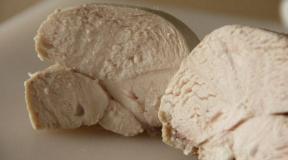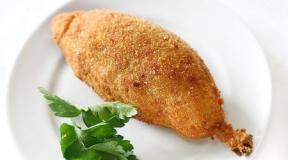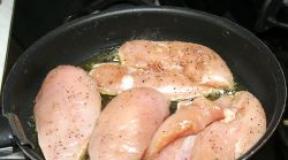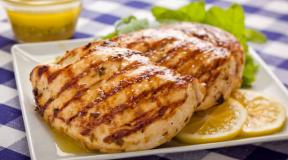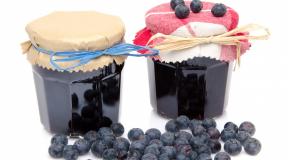Makar on the Crimean Tatar dish. Crimean Tatar cuisine
Each national cuisine has its own traditions. Crimean Tatar cuisine today is an interweaving of the traditions of the medieval Crimea and the taste traditions of Armenian, Ukrainian, Bulgarian, Turkish, Russian, German cuisine. So, for example, the Crimean Tatar plov has changed a lot. Traditionally, Crimean Tatars cooked it with raisins, barberries, peas, but without carrots. Now, how many people have housewives - so many varieties of pilaf, each prepares its own unique, and each differs in taste, sometimes quite strongly. Samsa, manti are dishes borrowed by Crimean Tatars from Uzbeks during their stay in Uzbekistan.
Butter and mutton fat are abundantly used in dishes. And not only in the main dishes, but also in sweets. For example, sweets made from puff pastry - "sheker kyik" were traditionally prepared on mutton fat - they were layered thin, like parchment paper, the dough, which was then sprinkled with sugar, twisted and cut into diamonds. Then sweet diamonds were fried in oil or baked in an oven. In addition to pastries, nuts, dried fruits, fruits, honey and jam were served for dessert. Tatars have always cooked jam in the Crimea - dogwood, walnut, squash, quince, wild pears and ranetok. Dogwood jam among the Tatars is branded, traditional, and their favorite nuts are walnuts and almonds. Vegetable dishes are widespread (more in the mountain-forest zone), food from flour and meat products(steppe zone), they eat a lot of fish and fish products (Southern Coasters).
Forms of food, types and methods of cooking in Crimean Tatars developed over the centuries, reflecting the lifestyle and climatic conditions of the place of residence. This is the result of centuries natural selection products, their combinations and methods of preparation. The cuisine of the steppe Crimean Tatars is distinguished by an abundance of meat, especially lamb, and dough. Mostly it is meat wrapped in dough. All steppe food, including a few vegetable dishes, - very satisfying, and sometimes even very fatty and heavy. There is a historical explanation for this. The steppes, being pastoralists and farmers, always worked hard, and often the main meal was in the morning, so satiety had to come quickly and last a long time, until sunset. As the Crimean Tatars themselves say, the steppe is meat, flour and milk. They ate fish extremely rarely - it is found only in one version - balyk-kebabs, when fish with rice or potatoes were laid out in layers in a pan and stewed, bay tomato sauce. Mushrooms were generally banned, they even had an indecent name in the common people. But meat and flour dishes combined with light fermented milk drinks here in special honor.
The diet of southerners is dominated by a variety of different vegetables, cereals and fruits, the most favorite of which are pumpkin and beans. There is even a dish that contains both of these products. They are initially boiled separately, then the pumpkin is ground to a paste-like state, combined with beans, onions fried in butter until golden brown are added, boiled for several minutes, put bitter capsicum close the lid and remove from heat. Southerners can find pumpkin in any combination: with dough, sugar, honey, dried fruits, pepper, salt, fruits, vegetables, legumes, meat ... Popular bean soup and young beans stewed with vegetables. They also cook mung bean porridge in combination with rice. Even in ancient times, vegetables on the South Coast were not only used as part of multi-component dishes and fresh, but also salted. V oak barrels fermented tomatoes, eggplants and peppers, covering the top with lids woven from vine. Tomatoes were salted with garlic and herbs, without adding water - in this form they were salted for several days. Eggplants were stuffed with carrots, tomatoes, herbs and garlic and salted under oppression. From apples and grapes they prepared fruit honey - bekmes, which turned out to be viscous and sweet.
The Crimean Tatars of the central part of the peninsula (orta yolak), due to the geographical features of their place of residence, combined in their cuisine the features of the steppe and southern coastal cuisines. They enjoy cooking and eating meat products, and vegetables. They especially like fruits and dried fruits. The third center is the capital of the Crimean Khanate, Bakhchisaray, whose inhabitants were distinguished by their love for refined and fine dining. Here for the family are preparing several unique dishes- sarma (what is wrapped, like our cabbage rolls, but not only in cabbage, but more often in a grape leaf), dolma (what is stuffed, for example, pepper). This is a very tender and fragrant bean soup with vegetables, this is pilaf with Crimean oblong pink or very satisfying crumbly rice, with raisins, barberry, small and low-fat pieces of fresh lamb. And also a lot of vegetables - eggplant, peppers, onions, garlic; fruits - pears, Crimean apples, grapes.
Now that we have considered the traditions of the three centers of Crimean Tatar cuisines separately, we can perhaps pay attention to the methods of preparing certain dishes. After all, it would seem that a dish under the same name is prepared differently at one or another center. For example, residents of the steppe part of Crimea in a dish of minced meat wrapped in cabbage leaves(like cabbage rolls) they always put onions, but the southerners are limited to tomatoes, carrots and herbs. Puff "snail" of thin simple test northerners call it “saryburma” with stuffing and cook it mainly with meat or with meat and potatoes, while residents of the South Shore prefer pumpkin and walnut stuffing, and even call the dish differently - fultu. Alishka-shorbasy - rich vegetable soup with eggs and a kind of dumplings - entered the Nogai menu many centuries ago. This soup is traditionally prepared without meat, with eggs. It, like borscht, is much tastier on the second or third day than on the first. On the South Coast, under this name, they know a completely different dish - bean soup with dough, which is cut into small cubes. Another example is such a dish as yufak ash - “small food” (small dumplings with broth). This dish is also prepared in different ways. For example, the Nogai broth is often with tomato. My grandmother (yalyboylu) fries a little flour in melted butter before serving and pours it on plates on a spoon. Some people just fry the onion in ghee. Kobete among the inhabitants of the steppe Crimea with broth, among the South Coast - without. Chebureks are more preferred by the steppe dwellers, the inhabitants of the South Coast prefer the yantyks. It would seem similar, but no, there are still differences. Thanks, probably, to such a variety of Crimean Tatar cuisine and attracts the attention of guests.
Ingredients
Beef brisket 1 kg.
Onion 3 pcs.
Beans 200 gr.
Potatoes 3-4 pcs.
Garlic 100 gr.
Bulgarian pepper 3 pcs.
Carrots 2 pcs.
Tomato paste 2 tbsp
Cabbage 500 gr.
Vegetable oil 250 gr.
Salt 50 gr.
Set of traditional spices
Cooking method
The main difference from traditional dishes other cuisines - in frying products in hot oil, characteristic of the Crimean Tatar cuisine
Put the beans to boil separate dishes without cover. Cut the meat into small pieces and fry in oil. In the process of frying, add chopped carrots (I usually cut into strips, but you can also grate), bell pepper(I used pickled bell pepper), onion...

Crimean Tatar meal - what is it like?

Crimean Tatars are great masters of delicious cooking and no less lovers of a leisurely meal. Any meal begins with a cup of the strongest freshly brewed coffee. Then appetizers certainly follow: cheese, cheese, olives, sausages, salads from fresh vegetables. In winter, when there are few fresh vegetables, marinades: lecho, pickled and salted vegetables harvested since autumn, and other home-made canned food. And, of course, freshly baked tandoor cakes.
Only tourists are limited to one or two dishes. V Crimean Tatar families they take the meal seriously: they put everything on the table at once: both snacks and hot dishes. For breakfast, in addition to snacks, they usually eat milk porridge, cottage cheese and dishes from it, for lunch - lagman, shurpa or yufak ...
Yufak - ash
Many dishes of the Crimean Tatars are a cross between a very thick soup or a second course generously flavored with broth. These are lagman, shurpa and ufak-ash
The word yufak-ash in translation means "small meal". And not because there is little food, but because the dish is a lot of tiny dumplings in the broth.
Women sculpt them all together quickly, quickly. But the work is almost jewelry, since each dumpling turns out to be the size of a fingernail, no more. V ready-made in a tablespoon they should fit six to seven pieces.
We will need following products:
For test:
Flour - 1.2 kg
Water - 0.5 l
Salt - 1 tbsp. l
Eggs - 2 pcs
For minced meat:
Meat (beef) - 1 kg
Onion - 1 pc.
Salt and pepper -...

Nokhutly - ash

It's fragrant beef stew With boiled chickpeas (chickpeas). In the Crimean Tatar language, chickpeas are called nohut, hence the name of the dish: food with chickpeas.
Meat (beef) - 1 kg
Chickpeas - 1 kg
Onion - 300 gr
Carrot - 200 gr
Vegetable oil - 600 mg
Salt - to taste
Red and black ground pepper- taste
We carefully sort the chickpeas, wash them, fill them with cold water and leave to stand for 3-4 hours. You can also soak it overnight. Then we add meat edges and bones for broth to chickpeas, add water so that it is about twice as much as chickpeas, put on fire and bring to a boil. Remove the foam and continue to cook over low heat until the chickpeas are ready. This may take up to 2...
Baklava eastern Crimean

1 egg
50g drain oil
1 tbsp milk
0.5 tsp soda
a pinch of salt
4 tbsp flour
4 tbsp honey
1l vegetable oil
2si.sugar
1 tbsp water
Melt the butter, add milk, egg, soda, salt, beat and knead a stiff dough. Roll it out thinly, wrap it on a rolling pin and grease the edges with protein so that they do not stick out. Cut into rhombuses, unfold and fry in hot oil. After frying, roll in syrup, bring to the table!
Bon Appetit!
Sent by Meryem Osmanova
Crimean pasties

200 grams
salt 1/5 tsp
water 80 milliliters
minced meat 150 grams
onion 1 piece
vegetable oil to taste
marjoram to taste
basil to taste
freshly ground black pepper to taste
The quantity of ingredients is calculated on 6 pieces.
Sift the flour with a slide, add salt ...
...and add water.
Knead a stiff dough. Knead it several times into a layer and fold it.
NB! The dough is very cool, hard to work with, but it should be so. After proofing, this will change and it will become softer and more elastic.
Leave the dough at room temperature for 30-40 minutes, covered with a film.
In minced meat (beef, lamb), consisting of meat and fat in a ratio of 4: 1, add 0.5 finely chopped onions. Second half...
"Yantykh" with minced chicken or turkey

Yantykh are Crimean chebureks that are fried completely without oil. They differ from ordinary chebureks only in a lighter appearance and also in the fact that much more onions are put into the minced meat than in chebureks, and no water is added. My grandmother made two versions of chebureks and yantykhs: festive, traditional recipe with lamb, and simpler, with chicken, explaining this by the fact that chicken is not fatty and is always perfectly baked. I always make chebureks and yantykhs with either turkey or chicken - although this is not quite traditional, it is very gentle. Since my recipe is not strictly traditional, I put the word YANTYKH in quotation marks.
Flour (1.5 cups - in the dough, and more, for sprinkling) - 2 stacks.
Salt - 0.3 tsp...
Ash-kashik

I remember this dish from my childhood. My mother is a Crimean Tatar, she cooked it incomparably! And my grandmother, my father's mother, said - your mother is economical, so she cooks such small dumplings! Although, in fact, this is a very painstaking work!
Flour - 300 g
Chicken egg - 1 pc.
Water (a little for the dough, the rest for the broth) - 1.5 l
Minced meat (any halal) - 200 g
Onion (medium, one in minced meat, 2nd in gravy) - 2 pcs
Carrot - 1 piece
tomato (or tomato paste) - 1 PC
Butter - 2 tbsp. l.
Salt (to taste)
Black pepper (ground, to taste)
Let's start by preparing minced meat and dough, count on the number of people you are going to feed.
Add finely chopped onion to minced meat, salt and ...
Qalakai

Ingredients
Butter - 200 g, one egg, flour - 3 cups, a pinch of salt, 0.5 teaspoon of soda, slaked vinegar, turmeric (this is not necessary, but will give a bright yellow color)
Melt the butter, add one egg to the flour, add slaked soda. Combine the resulting mixtures and knead a stiff dough. You can also add turmeric to the dough - this will give the product a bright yellow color. Put the dough on a baking sheet, bake for 40 minutes at a temperature of 180-200 degrees.
Recipe from Rustem Ibadlaev
Photo: Dilyara Sufyanova
Yantyk

Yantyk is a cheburek from unleavened dough, which is fried in a dry frying pan. It can be cooked with various fillings. We offer one of the cooking methods.
Ingredients
For the dough: water - 1.5 cups, salt - to taste, flour. For filling: chopped meat or cheese, herbs, water.
Knead the dough for pasties, leave for 15 minutes, then knead again. Divide into 8 parts, roll out thinly. Salt the minced meat, pepper, add herbs and a little water (less than in pasties). Arrange on a cake, seal the edges well so that water does not flow into the pan during frying. Bake in a dry, well-heated pan. Sprinkle with water, brush with butter and cover with a plate.
rus4all. en
Crimean Tatar pasties

Ingredients
flour - 500 g, minced meat - 300 g, water - 190-250 ml, onions - 150 g, meat broth - 4-6 tbsp. spoons, salt, spices - to taste, vegetable oil - for frying.
Sift flour into a bowl, add a pinch of salt. Mix well and pour in a little less than 1/2 teaspoon vegetable oil. Rub the flour with butter thoroughly with your hands, knead each lump. Continuing to knead, gradually pour in water until the dough rolls into a ball. Ready dough will be quite tight and a little lumpy. Wrap it up in cling film and leave for 40-60 minutes on the table. During this time, the flour will be saturated with water, the dough will become elastic.
Place minced meat in a large bowl. Peel the onion and grate...
sarah burmese

Ingredients
Flour - 2-3 cups
vegetable oil - 2-3 tbsp. spoons (for dough)
150-200 g melted margarine (grease)
water or serum
salt, spices.
Meat (beef or lamb is fatter, it is good to add fat tail fat),
potatoes - 1-2 pcs.,
onions - 1-2 pcs.
Prepare the dough: flour, water and vegetable oil, refrigerate.
While the dough is infused, let's take care of the filling - grind the meat in a convenient way for us - with a meat grinder, blender, cut the onion smaller, potatoes into small cubes, mix everything. Add seasonings - pepper, cilantro, zra, you can have a couple of cloves of finely chopped garlic, etc.
Divide the dough into 2 parts. Roll out each piece into a thin layer round shape, grease each with oil, lay them on top of each other - one of the options for puff pastry is obtained. Then lay out the filling, roll up, put in a frying pan, greased with oil.
Bake 30-35 minutes.
Dear readers, as promised, I reveal to you the secrets and tastes of the Crimean cuisine. I invite you to walk through the kitchens with me. local residents, look under the lid of each pot and pan. Find out what to cook in Crimean style; how Crimean dishes differ from those familiar to us, as well as recipes of Crimean cuisine. Read on.
Crimean cuisine - what is it like?
In this article I will tell you about the recipes for traditional dishes that are prepared on conventional kitchens, ordinary Crimean housewives every day.
I will not give recipes for Crimean Tatar cuisine. More than once, in my articles, I told you how to cook belyashi, pasties, samsa, shurpa, lagman or pilaf. And what do the Crimeans, our former compatriots, eat?
Crimean cuisine / Culinary notes from Crimea
 Crimean cuisine differs from ours in an abundance of fresh vegetables and fruits grown in the gentle southern sun. Everything grows nearby, imported is rare, only in the off-season.
Crimean cuisine differs from ours in an abundance of fresh vegetables and fruits grown in the gentle southern sun. Everything grows nearby, imported is rare, only in the off-season.
Crimean vegetables are a different story. Such tomatoes, as in the Crimea, I personally have not eaten for 15 years.
Once upon a time, my mother brought several tomatoes from a business trip, my grandmother carefully collected the seeds and then grew delicious tomatoes from them. They were of different colors and shapes. I still remember the taste and aroma of those tomatoes.
There are tomatoes in Russia and they are on sale all year round, but I can't get rid of the thought that they remind me of rubber balls. Only when I come here, to the Crimea, do I remember what tomatoes really should be like.
As befits the southern edge, there are a lot of fruits in the Crimea. Crimean fruits are a bright multi-colored variety.
On the market stalls they lie in slides juicy peaches and apricots, sweet cherries, sour cherry plums and plums, honey figs, homemade pears and grapes, melons and, of course, watermelons.
There are many other little-known fruits and fruits that are so pleasing to the eye and taste of the inhabitant. middle lane that "you will eat with one eye".
But the Crimean land is rich not only in fruits and vegetables. Crimean peninsula It is washed by two seas at once: the Black and the Sea of Azov.
It cannot be said that fishing is the main industry here, there are quite a few fish in these seas. However, southern bazaars or deliveries are abundant in trays with fresh Black Sea fish and seafood delicacies.
Prices bite, and aromas just drive you crazy, but your hands are reaching out for smoked squid or garfish, dried mullet or gobies, mussels or rapana.
Meat and dairy products of local production are much better in quality than ours. Milk from a bag tastes like boiled milk from domestic cow, cheese is similar to cheese, and ready-made chicken products are fresh and available to anyone.
Well, how can you not cook something tasty here?
Crimean cuisine recipes
 If you go to a cafe or a restaurant in Crimea, then the menu offers us dishes of mixed cuisine, something semi-European, semi-Crimean, semi-Tatar. That is, in the usual borsch you can find bell peppers, tomato slices, beans, oriental spices etc.
If you go to a cafe or a restaurant in Crimea, then the menu offers us dishes of mixed cuisine, something semi-European, semi-Crimean, semi-Tatar. That is, in the usual borsch you can find bell peppers, tomato slices, beans, oriental spices etc.
Interesting and quite delicious combination, distinguishes modern Crimean cuisine as a separate culinary direction.
You can be sure that Crimean women cook extraordinary soups or pies in their kitchens. Even pasties known to everyone, they fry in different ways, with other fillings and on a simple dough.
One of my Crimean friends shared a recipe fast chebureks in Crimean style and other dishes from their home menu.
Chebureks in Crimean
Ingredients:
- grated cheese
- tomatoes
- garlic
- salt to taste
Cooking method:
- Cut the tomatoes into small cubes, lightly salt, add the garlic passed through the press and grated cheese.
- cook dumpling dough.
- Cut the dough into pieces, roll into balls.
- Then roll out the dough very thinly.
- Spread the filling on one edge of the dough, cover with the second edge and cut off the excess with a special wheel knife.
- Fry in odorless vegetable oil. Pasties in this way should be eaten while hot. Bon Appetit!
Interestingly, the basis of the Crimean chebureks is the recipe for Karaite chebureks, a traditional national dish indigenous inhabitants of the Crimea and Evpatoria, in particular, the Karaites.
The original recipe included one or two eggs, flour, salt and dried garlic in powder. Water or any other liquid is not added to Karaite chebureks.
Only eggs, flour and salt to taste. Garlic powder last. And in the filling instead of cheese they put cottage cheese, grated with raw eggs, fresh tomatoes and greenery. Modern version I like chebureks more.
Try to cook Crimean pasties yourself and you will definitely want to cook them every day!
Grilled quick pies
Ingredients:
- lavash thin
- stuffing like pasties above, if desired, you can use boiled meat or fish
- olive or corn oil
Cooking method:
- Prepare the filling as for chebureks.
- Unroll pita bread, cut into squares and grease with any vegetable oil.
- Put the filling on the squares, roll into envelopes and put on the grill grate.
- Cook for 3-5 minutes on each side of the envelope and serve immediately.
Crimean fish
Ingredients:
- any boneless fish, you can pollock, mullet or even hake
- sugar
- tomato paste
- vegetable oil
- onion
Cooking method:
- Cut the fish into portions, add salt, roll in flour and fry in vegetable oil.
- Put the fish on a plate, and fry the onion in small strips and tomato paste in the same oil. Add water and simmer over medium heat until sauce thickens to desired consistency. Salt and add a little sugar.
- Put the pieces into the boiling sauce fried fish, bring to a boil and reduce heat.
- Stew the fish in the sauce for a few minutes, then close the lid and remove from the stove. The fish should be infused for at least 20 minutes. Ready fish good both hot and cold.
Crimeans add various vegetables to borscht, so no one will give an exact recipe. Everything that is in the garden may well end up in soup, borscht, shurpa or stew.
The main thing is not to overcook the dish to a puree state and add a lot of fresh herbs and spices.
Help yourself Crimean dishes and be healthy!
Always your Alena Tereshina.
The rich subtropical nature of the Crimea is so densely mixed here with the traditions of the Tatars that the cuisine turned out to be unusually diverse.“To visit the Crimea and not try the Crimean Tatar cuisine is a sin that was not included in the list of mortals because of its obviousness,” one of my acquaintances said, paraphrasing the words of the poet Alexander Karpov. And one cannot but agree with him. Firstly, you can’t try the dishes of the Crimean Tatars anywhere except Crimea, except perhaps for certain places in Kazakhstan and Uzbekistan, where these people were deported after the war. Secondly, this is the most inexpensive and at the same time the highest quality food on the peninsula. And finally, it is so delicious that, having tasted one dish, it is impossible not to try the whole menu.
Tradition and eclecticism
The rich subtropical nature of the Crimea is so densely mixed here with the traditions of the Tatars that the cuisine turned out to be unusually diverse. Here and meat in all forms: fried on open fire and on coals, stewed, boiled, grilled, dried and salted. There are thick soups, and pilafs, manti, dolma, and milk-cheese delights, and pastries that amaze with their variety. In addition, for centuries, the culture of the Crimean Tatars came into contact with the cultures of other peoples, and traditional cuisine absorbed many of their eating habits. Russia, Ukraine, the Caucasian peoples, Turkey and even Greece influenced it and modified the traditions of cooking certain dishes. One has only to look at the sweets that the Crimean Tatars are now preparing. Next to the traditional airy lace baklava, originally Crimean Tatar, now it is obligatory Baku, Turkish baklava and even chak-chak, characteristic of Kazan Tatars. And miniature yufahash - why not ravioli!

True, even in the Crimea itself, the traditions of the cuisine of the steppe Tatars differ from the passions of those representatives of the people who settled along Black Sea coast. The former have respect for meat and dairy dishes, while the latter generously flavor their table with fruits and vegetables. To see the Crimean Tatar cuisine in all its glory, the Mir TV and Radio Broadcasting Company correspondent went to the top of Mount Ai-Petri, where over the past 10-15 years a whole village of Crimean Tatars has grown up, who have moved here from the coast and from the steppe part.
To the mountains beyond the peaks of culinary

The main occupation of these people is to treat. From the very morning there is preparation for the reception of guests. Daughter tanned and weather-beaten, people heat wood-burning stoves, heat cauldrons on them, chop vegetables and chop meat. Many do it in strict silence, waving away the camera. “I don’t talk while I work,” one of the chefs explains. “Don’t take it off, you’re distracting me.” Cooking does not like fuss."



Tourists and vacationers climbing the mountain are immediately confronted with an onslaught of touts who vied with each other to praise their restaurant or cafe. If tourist groups come up, then the chef or the owner comes out in person and gives a whole lecture, talking about the dishes and immediately showing them in all their glory. Artistry these people do not hold, and go to every second restaurant. It is customary to cook here right on the street, in huge cauldrons installed in the hole of a wood-burning stove. Aromas of spices mix with the resinous smells of the grove on the heated mountain slopes, and subtly draws wood smoke and honey. They and dried mountain herbs are sold here both from stalls and from cars. Moreover, the owner of any restaurant is ready to gladly bring you golden and amber jars.

I go through the ranks, barking, asking what they are cooking. Find out what they don't have. For some reason, no one cooks kubete - a traditional Crimean Tatar lamb pie. I decide that I will stop where I find such a pie. “Kubeta? No, we cook for ourselves at home, but not here. Tourists don't know what it is. You are the first to ask,” smiling young and older, tanned people. Almost everyone here has smiles sparkling with golden crowns: it’s more beautiful that way. Finally, an elderly woman catches up with me from a very small cafe. “You wanted a cubete? Go, we cooked for ourselves in the morning, but there was a piece left for you. Try it, it's delicious!"
Getting in. Right in the hall, at the far table, on an embroidered towel, a woman in an apron quickly and quickly molds tiny dumplings - the size of a fingernail, no more. The woman's fingers are much larger and it is not clear how they cope so quickly with almost jewelry work.

“This is Yufahash,” explains the owner of the restaurant, Dilyara Asanova. - Our young wife prepares such dumplings on the second day after the wedding. It is believed that this is how she shows her skill and patience. See how tiny they are? To feed a family, one must learn how to cook them very quickly. The smaller the dumplings, the better. On a spoon should fit from 10 to 15 pieces, and even more.

Yufahash
Yufahash means "little meal". To make such dumplings, it is better not to roll out all the dough - it has time to dry out while work is in progress. Having rolled out part of the dough, and cut into tiny squares, the hostess covers part of them with a towel so that they do not wind up. On the rest, she puts a tiny, neat ball of minced meat. Prepare a dozen and sculpt. A quick flick of your fingers creates tiny round envelopes. Then the next ten go to work. Better, of course, sculpt cheerful company, but even one patient hostess can do this work.

For the test, you need to mix 2 eggs, 200 grams of water, a quarter teaspoon of salt. Pour about 0.5 kilograms of flour into a bowl in a slide, make a recess and pour a mixture of water and eggs into this recess. Knead the dough, gradually adding more flour if necessary. It should be tough but soft. We roll the dough into a ball, cover with a napkin and send it to the refrigerator for 40 minutes.
We prepare the filling: we make minced beef, it is good to add a little beef or lamb fat to it. Finely chop the onion with a knife. I use a special grater, and then chop with a knife. The pieces should be millimeter-sized so that at least a piece gets into each tiny dumpling. Mix onion with meat at the rate of one tablespoon of chopped onion per 0.5 kg of beef, add black pepper and salt to taste, a little cold water. Now the minced meat must be thoroughly kneaded and beaten so that it absorbs water. Then the mass turns out to be more plastic and small pieces are separated from it more easily. When pressing on the stuffing, water should not stand out from it. Now thinly roll out the dough and cut it into pieces 1.5 by 1.5 cm or a little more. We make dumplings, put them on a tray in one layer. We store in the refrigerator. In principle, they can be frozen, but we always cook just before eating.
Cooked dumplings are eaten with broth. Diced onion should be fried until golden brown in butter, then add to boiling water at the rate of 2 tablespoons per two-liter saucepan. Salt. Put dumplings into this broth so that you get a thick soup. Bring to a boil and cook for 2-3 minutes. Everything. Pour into deep plates and you can enjoy a leisurely meal. It turns out both the first and second dish in one.
Shurpa, Lagman and their variants
There are many dishes in the Crimean Tatar cuisine that look like a very thick soup. Such are shurpa and lagman.

Shurpa(shorba, chorba) - fragrant soup lamb with coarsely chopped vegetables. Sometimes it is cooked with chickpeas. Peas should be soaked 4-5 hours before cooking, or just leave it in water overnight. Shurpa is cooked in a cast-iron cauldron.
Half a glass of sunflower oil is poured into a heated cauldron and pieces of lamb are lowered. The meat should be fried a little, then add 2-3 cloves of finely chopped garlic there. When it turns golden, add water. For 1 kg of lamb, 2.5 liters will be required. It is necessary to bring the broth to a boil, remove the foam and cook for 30-40 minutes. Then add 100 g of chickpeas and cook for another 1 hour.
Peel vegetables: 500 g potatoes, 3 large carrots, 3 onions, 2 bell peppers. Cut the onion into half rings, pepper - into large slices, carrots - into long slices obliquely, tomatoes 2-3 pcs. cut into quarters, chop 1 bunch of parsley. We cut the potatoes into halves, large ones can be into quarters, we put quite small potatoes whole.
When the meat began to separate from the bones, salt and pepper the broth, put Bay leaf. Lay chopped vegetables: carrots, then onions and potatoes, let it boil for 5 minutes, add bell peppers and tomatoes. Just before the end, put the greens and bring to a boil for the last time. We make sure that every serving is sure to get good piece meat. It's pretty fat and rich soup, very hearty meal, to which lamb gives a thick and peculiar taste.
I must say that several variants of shurpa are being prepared in the Crimea. The Tatars living in the steppe part cook it without sweet pepper and tomato, and on the coast you can find shurpa with vegetables but without chickpeas, in which they put a lot different greens and straight into the plate - cut into thin half rings raw onion. Sometimes raw or pickled onions are served separately with shurpa.
Lagman- it homemade noodles with thick meat sauce in which vegetables are cooked.
Cooking noodles. For a test for 250 g of flour, you will need 130 ml of water, 1 teaspoon of salt and 25 g of vegetable oil. kneading thick dough, it should be kneaded for 10 minutes, and then cover with a napkin and leave for 1 hour. After an hour, you still need to knead the dough, roll it thinly, cut into squares and roll each into a sausage. Dip sausages in sunflower oil and leave to rest for 10 minutes. Then we roll each one and stretch it with a rolling pin on the table so that it becomes even thinner, but does not tear. Roll up again, leave for a while. Then we take the sausage, cut it with a knife to make very thin strips. We unfold them, fold them in half and four times, take them along the edges and slap them on the table so that, when stretched, they become even thinner, turn into threads. We lay these threads on the table, we do the same with all the other blanks.
Bring a large pot of water to a boil, dip the noodles into it and immediately stir so that it does not stick together. Cook for 3-5 minutes. Drain the water into a separate bowl. It will come in handy for making the sauce. Add a little vegetable oil to the noodles and mix. Ready noodles can be stored in the refrigerator, put in a bag. In this case, before serving, it must be poured with boiling water.
For gravy at the bottom of the cauldron, not heated to the maximum, we drown the interior mutton fat, cut into pieces. It needs 150 grams. When the fat is melted, we take out the greaves and throw in the same flat long pieces of lamb pulp, cut across the fibers (as in the basics). Fry until golden brown.
We clean and cut vegetables. For 400 grams of lamb, you will need 3 onions in semicircles, 2 carrots in large strips, 2 potatoes in strips, 400 grams of tomato cubes, 4 sweet peppers in slices, 3 finely chopped garlic cloves, chopped parsley and celery - 100 grams._
When the meat is fried and the juice has evaporated from it, fry the onion in the same place until golden brown, then carrots, bell peppers. We send potatoes next. Salt, add spices: cumin, black pepper and paprika to taste. Mix everything and simmer for 7-10 minutes. Then add the broth left over from cooking the noodles. It must be added so much that the result is not a soup, but a thick vegetable gravy with meat. Cook for a few more minutes. In deep large bowls we lay out the noodles, which must first be scalded with boiling water. Spread the gravy with vegetables and meat on top and serve.

Cheburek, yantyk, samsa
The most famous and widespread dish of the Crimean Tatars is pasties. Che - Borek pie - meat.

Thin meat pies fried in in large numbers of hot oil have become an integral part of the cooking of many Russian housewives, the fame of this dish has spread so widely. In the Crimean Tatar tradition, they are made with minced lamb or half beef and lamb. Another version of the same pies, but fried in a dry frying pan without oil, is called yantyk.

In the Crimean Tatar cuisine, in general, there are a lot of dough products. Both from fresh, and from rich, and from puff.
Absolutely must try the tandoor samsa. This is another lamb patty, very hearty (finely chopped tail fat is chopped there), with coarsely chopped onion and chopped pieces meat, heavily peppered and flavored with spices. However, now they are preparing a more adapted version, with less pepper and spices.
The same kubete pie that I was looking for and found on Ai-Petri is beautiful. It's closed juicy pie with lamb, potatoes, onions and spices, which is baked in the oven and served, like all lamb dishes, hot. In this cake, Tatar housewives leave a small hole on top. When the cake is browned, 10 minutes before removing it from the oven, a piece is placed in this hole butter and add a few tablespoons of hot meat broth. This trick provides the dish with extraordinary juiciness and tenderness.
The feast does not like fuss
Of course, Crimean Tatars cook both salads and a lot of cereals and bean dishes, which are not found in the menu of restaurants. They do not belong to the festive feast, these are dishes for every day that are eaten at home. As true Muslims, the Crimean Tatars do not recognize pork and use only beef, lamb and poultry. They know a lot about meat here! It is not for nothing that the commonly used word kebab comes from the Crimean Tatar “shish lik”, “shish” - spit, “lik” - for, that is, what is intended for the spit. Cooking on charcoal different variants lula kebab.

The real king of the feast is plov. It is cooked here strictly traditional, without dried fruits, as in Uzbekistan, without chickpeas, as in Tajikistan. But with what solemnity they approach its manufacture! This is a whole sacrament that does not tolerate not the slightest liberties. Everything must be done on time, to the nearest second. And the onions will brown exactly to light gold, and the carrots will give juice, but not soften. Under no circumstances should meat be salted. Salt and spices - only when rice is already laid in the dish and boils a little. The author of the dish masterfully maintains exactly the kind of heat in the oven that is needed at every stage, otherwise everything will be spoiled. And no talking during work, so as not to miss the right moment to bookmark the next serving of ingredients.

Crimean Tatars are big fans of tea, including tea infused with herbs. Drink it strong, hot, often adding milk. Tea drinking lasts a long time, and the guest is given water from tiny bowls so that the tea does not have time to cool, and the hostess constantly showed attention to the guest, pouring flavored drink. Tea is served with baked goods and honey. This is my favorite sweet.
Most Crimean Tatar restaurants are halal. Alcohol is not sold here. But with all their hearts they love to feed deliciously and know a lot about it. True, in Crimea, for the sake of non-Muslim guests, the hosts usually do not mind if they bring wine with them. Indeed, when meeting with such a varied cuisine, heavily flavored with spices and the chefs' love for their work, how not to raise a toast "for moderation in excesses"!
Tatyana Rubleva
Having traveled around the Crimea and tried baklava, many begin to be interested in how to cook it at home. Baklava (or baklava) is considered a popular puff pastry confection. The recipe for Turkish baklava is not very complicated. As a rule, baklava has a filling of nuts, and is doused with sugar syrup. This dish is widespread in eastern countries, it has gained wide popularity in the Crimea. For the first time, sweets were mentioned in the 15th century. Since then, baklava has been cooked during every holiday. According to another version...
Having been in the Crimea, you must definitely try the wines of Massandra. In Crimea, there are several areas where simply unique grape varieties are grown. One of these areas is called Sun Valley. It is located near Sudak. It is the only place in the world where grape varieties such as Ekip Kara, Jivat Kara and Effessia are grown. Crimean winemakers make Black Doctor and Black Colonel wines from this grape. Not far from Alushta is the small village of Krasnokamenka, which got its name from the name of the Red Stone. This is the only place where grapes are grown…
Translated from Turkish Turkish Delight means means - pieces of pleasure or happy pieces. This exquisite sweetness is more than half a century old. Previously, only water, sugar, starch and essence from rose petals were used to make Turkish delight. In the 18th century, lokum was a popular sweet in the Sultan's harem. What is Turkish Delight? The form of Turkish Delight can be: cubic (when the sweetness is in the shape of a cube) children's (in the shape of animals) in the form of a roll two-layer sliced whole Arabic (when the delight is in the shape of a parallelepiped) Nowadays, each cook has his own unique …
Dolma (sarma) - meat filling wrapped in young grape leaves. Served with sour cream or fermented milk product yogurt. As a filling, either lamb or beef is most often used, it will be very tasty if you mix these two types of meat together. However, most likely the dish was borrowed from Greek cuisine, which at that time already had rich culinary traditions. Stuffed vegetables, were considered a luxurious delicacy, which was prepared only for the elite. The dish was considered difficult for those times, it required special skills of the cook. A harmonious combination of vegetables ...
How to cook lula kebab? Kebab means "fried meat" in Persian. This dish is especially loved to cook in the Crimea, the recipe came to the peninsula from Arab countries. Lula kebab is a cutlet fried on a skewer. Traditionally, kebab is made from juicy lamb with addition onion. Lamb is used for cooking very fatty, and a lot of onions are added. In comparison with cutlets, kebab has specific differences - neither eggs nor bread are placed in the dish. But in without fail garlic is generously added to the meat, ...
It is impossible not to fall in love with Crimean pasties. Fragrant, juicy, with a crispy crust - they literally melt in your mouth! You can learn how to make real Crimean chebureks yourself. All you need to do is put in a little effort and get used to it. step by step recipe Crimean chebureks with photo. To prepare Crimean chebureks, we need the following products: 3 cups flour 3/4 cup water 1 egg yolk 150 ml vegetable oil (1/3 cup for making dough, the rest is needed for frying chebureks) 1 teaspoon of salt (half for dough, half ...
Shurpa, which is very popular in the Crimea, is also known all over the world under other names - chorpa, chorba, shorpo, sorpa. The shurpa recipe is one of the most ancient. It consists of the best and selected products - fresh fatty meat, vegetables and fruits, fragrant spices and greens. Shurpa is prepared in many countries. In Crimea, you can taste this dish in many cafes and restaurants. There are a lot of recipes for making shurpa, we have chosen only the best of them. What ingredients do you need to prepare...
Crimean cuisine - what should you definitely try when traveling around the peninsula? So that you do not get confused with the names of dishes in cafes and restaurants, we will tell you about the most popular dishes in the Crimea. Crimean cuisine - the most popular dishes Kyashik-ash - soup made from very small dumplings with meat stuffing, served with broth, seasoned with curdled milk or yogurt. The size of the dumplings speaks of the mastery of the hostess, in a spoon they should fit 6-7 pieces. Shurpa - strong broth from lamb, in which they put carrots, onions and, in ...
Crimean wines– you can’t not try them after visiting the peninsula! For more than 2 thousand years, vineyards have been cultivated on the lands of the peninsula. The berry was grown by Taurians and Greeks, Russians and Tatars, Christians and Muslims. More than 100 local grape varieties were bred, and the volume of wine production in Crimea is comparable to that of Georgia, Italy, Spain and France. About winemaking in Crimea Unary table wines are aged in oak containers for no more than a year. They are intended for everyday use. The wine industry in Crimea unites more than 100 enterprises. The area of Crimean vineyards ...
How to taste wine is a whole ritual, the magic of which lies in certain nuances. Wine tasting is fundamentally different from tasting spirits, which often do not have a pronounced taste and are tasted by smell. Before wine tasting, it is not recommended to consume foods and drinks that leave a long aftertaste and affect the perception of wines. These include menthol candies, chewing gums, coffee, chocolate, spicy dishes. Do not smoke or inhale tobacco smoke. Wine tasting at Massandra Wine tastings at Massandra are served 9 …
Crimean tea is sold everywhere on the peninsula. Many people buy it as a souvenir to bring to their relatives. However, few people know that he is one of the best healers for various diseases. The composition of the Crimean tea includes up to 55 various kinds herbs! A folk saying says: Herbs for Crimean tea are collected in the most beautiful ecologically clean areas of the peninsula. They drink Crimean tea, adding honey or rose petal jam to it to taste. More than 300 species grow in Crimea medicinal herbs applied in folk medicine, …
Already on the street not far from the oriental coffee houses you can hear a subtle charming and unique aroma coffee brewed in the sand. beautiful girls dressed in national clothes offer to taste coffee on the sand together with oriental sweets- bakhlova, Turkish delight and all kinds of cakes. It is very difficult to refuse such an offer. Many tourists, having visited such an institution in the Crimea at least once, coming next year, definitely visit it again. But why not indulge in an exquisite oriental meal right at home? How to make coffee in the sand...
